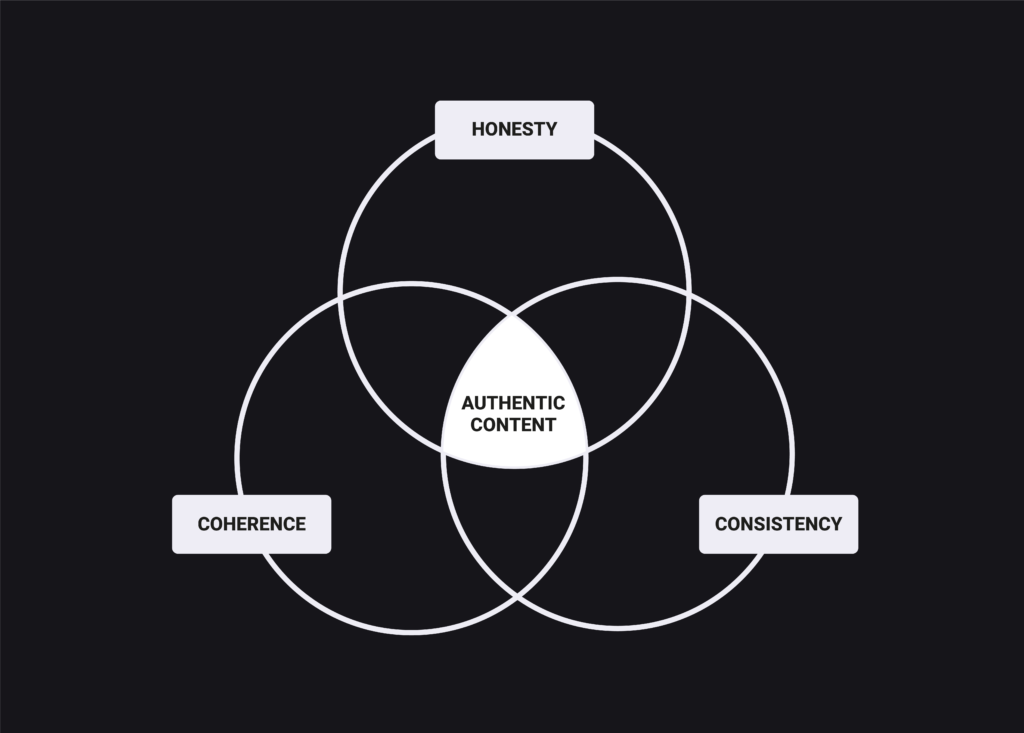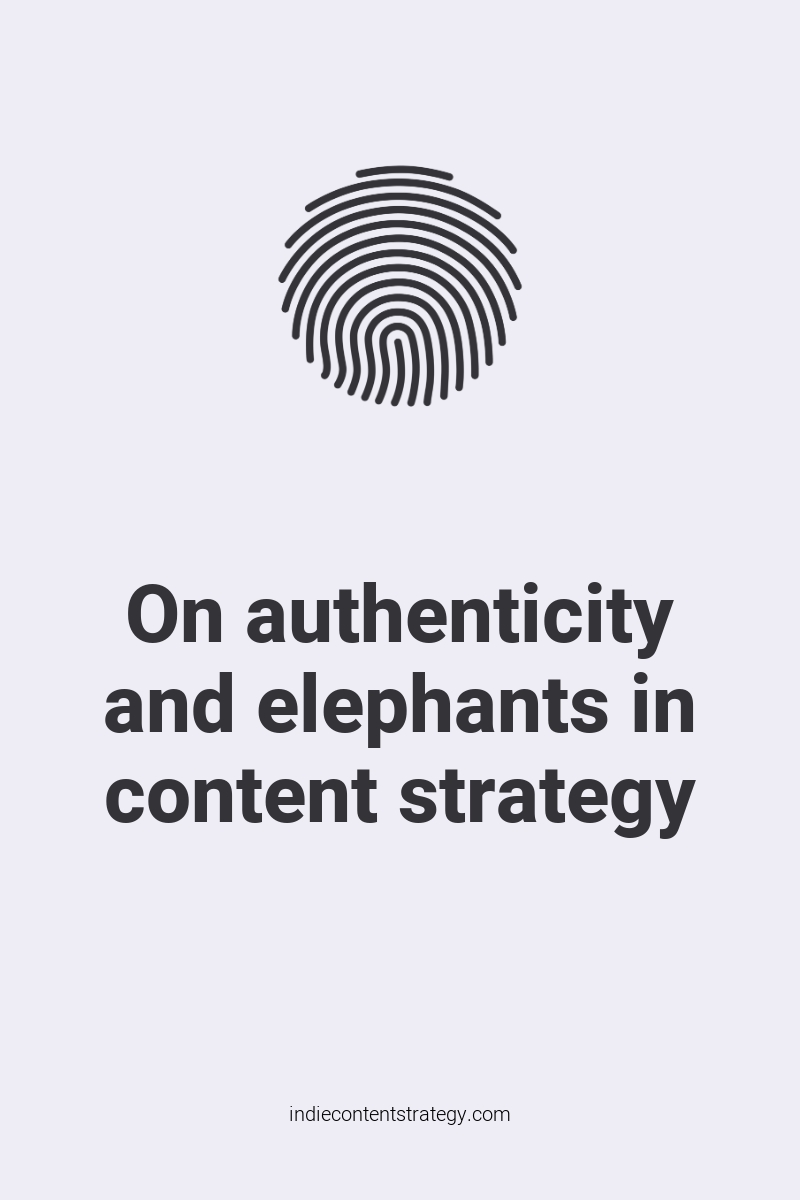Have you ever liked one of those tweets advising founders to build authentic businesses? Yeah, me too. They go semi-viral all the time, because it sounds like an easy out. Being authentic… That means we just need to be ourselves to be successful, right? Honestly, without further context, it’s just inspirational blah.
Retweeting it is easy, but what does it really mean for your content work? How do we create content for an authentic brand? My answer is elephants.
People crave authentic brands
As blah as it sounds, authenticity is a powerful concept. As a small business or solo founder you, your experiences, your knowledge and view on things is the most valuable asset you have. In a world where people are yearning for brands they can relate to (especially we damn millennials, who seem to keep on killing traditional industries), being small is a huge advantage: You don’t need to create a corporate culture around shared values – you just need to leverage your own values.
To understand how we can use authenticity and create authentic content, I think we need to talk about three core concepts: Honesty, Coherence and Consistency.

This is where the elephant comes in.
What authenticity has to do with elephants
Do you know the Indian parable of The Blind Men and the Elephant?
It’s about a group of blind men who heard of this strange new animal – an elephant – being in town, and decide to go and find out more about it. When they find the elephant, they start touching it to find out how its shaped. As the elephant is so big, they all touch different body parts: Its trunk, its tusks, its feet.. They describe the elephant to each other, based on what they feel. But as their experiences and descriptions are so different, everyone thinks the other is lying, and they start to argue who’s right.
It’s a lesson about conflict that arises when people only see things from their subjective point of view. Every one of the men is speaking the truth, but their experience is limited.
To explore what authentic content has to deliver, we need to imagine we’re the elephant in this scenario.
Honesty – Be an elephant, not a sports car
People reading our content are like the blind men wanting to know what the heck an elephant is. They have no concept of our product or us as a company yet.
What good would it do if we pretended to be a sports car? We don’t even know how engines work! On closer inspection, they will find out we’ve been faking the roaring exhaust noises.
Trying to be something you’re not – like a big corporate – will catch up with you eventually. As an indie founder you just can’t keep up that facade. It’s exhausting and it will keep you from having real, insightful conversations with the people you want to create value for. Being honest helps you find the right audience: People who can relate to you and your point of view. (Paul Jarvis calls them your rat people.)
Vulnerability as a strength
So what keeps us from being honest?
Showing who we are is scary. It makes us feel vulnerable. Pretending to be excited about things we find boring, or pretending to be a bigger company is like a security layer: People won’t judge us as a person, but the fabricated idea of our business. That’s probably the hardest part of authenticity, but it’s beneficial in business and every other part of your life – that’s what the vulnerability & shame researcher Brené Brown discovered.
“Authentic vulnerability and transparency are strengths masquerading as weaknesses.”
Travis McKnight
in: The Untapped Power of Vulnerability & Transparency in Content Strategy
Unreflected vs reflected honesty
Still, authenticity does not equal radical candor, and I think we shouldn’t mistake it for just speaking our mind. While transparency is important, Seth Godin points out that we shouldn’t aspire to authenticity as an impulse. We shouldn’t share every thought or feeling in a knee-jerk reaction.
I really think we need to act and speak honestly about the things we do and know as a business, but we need to reflect upon what we share and why (which happens to be an important part of a content strategy!). Not because we want to manipulate people – but because we want to be reliable and show people what they can expect from us.
Coherence – Chunk the elephant
Back to the blind men: The had to touch separate body parts to base their assumptions on, because the whole elephant was impossible to grasp at once.
Every piece of content we put out is like showing a part of us, the elephant. We better make sure those parts fit together so people can piece together the whole animal eventually. We can do this by making sure our messaging is the same across all our content, and it reflects who we are and who we want to be as a company. Margot Bloomstein shares how to create a message architecture for your content in her book Content Strategy at Work, and it’s one of the guidelines that I think every company should define – even if you’re just one person. (She also used the parable of the Blind Men and the Elephant to illustrate the concept of coherence in one of my courses first. I only stole it for this article!*)
Do we want people to see us as a down-to-earth friend? Or do we want to be perceived as a brave inventor? It makes a difference in how we talk. We’re probably a bit of both, but how do we want our customers to see us so they can relate to us in context of the specific problem our product solves? We need to choose deliberately …
Consistency – Trudge on
… and then be consistent. Trudging on, just like an elephant.
Are you sick of my analogy yet? #sorrynotsorry – this video by the Headspace meditation app just fit too well:
You can’t build a business without showing up, consistently. “Slow but steady” describes how most indie businesses work very well: No erratic pivots, no jumping around on your opinions. In the same way, being consistent in what content you put out when will help people understand what to expect from you. It’s another facet of being reliable.
Consistency is a topic I’ve also encountered a lot in my research about content strategy for bootstrappers. All of the founders I’ve interviewed identified it as one of the key ingredients to their content success.
Authenticity is not a switch
To be authentic, we need to explore who we are (the hard part!), how we want to be perceived, and consistently create coherent content. Honesty, coherence, consistency.
Does that sound like a lot to navigate? Because it is! It’s definitely not easy, and we will have to do some soul-searching as well (I’ve written about exploring your personal story for branding before, if you need a starting point).
While I do think that being authentic is something you should strive for, it will rather be a journey than a perfectly planned strategy. To me, becoming authentic is the better goal than being authentic. (It’s my goal, at least!)
So, you tell me: How does that elephant look like again?
* Reading suggestions & a note about elephants
The metaphor of the elephant has often been used in content strategy, because content is where all the different parts of a business come together. One of the first articles popularizing the topic by Kristina Halvorson on A List Apart (from 2008!) even uses it as its title image.
My article was especially inspired by Margot Bloomstein, who used the story of the blind men as an analogy in my course about brand values & message architecture to make a great point about coherence.
So this article is just remixing thoughts of many brilliant people. Read more from them here:
- Seth Godin’s Blog and his book This is Marketing
- Content Strategy at Work by Margot Bloomstein (showing you a process to define your message architecture)
- Rats by Paul Jarvis (an essay about finding the right audience)
- Company of One by Paul Jarvis (which has a lot to do with acting true to your values and goals as a founder)
- The Untapped Power of Vulnerability & Transparency in Content Strategy by Travis McKnight (delivering a lot more actionable insights on how to craft content that shows vulnerability & transparency)
- Brené Brown’s books – especially Daring Greatly (which show you how to cultivate vulnerability and will help you go all in)



